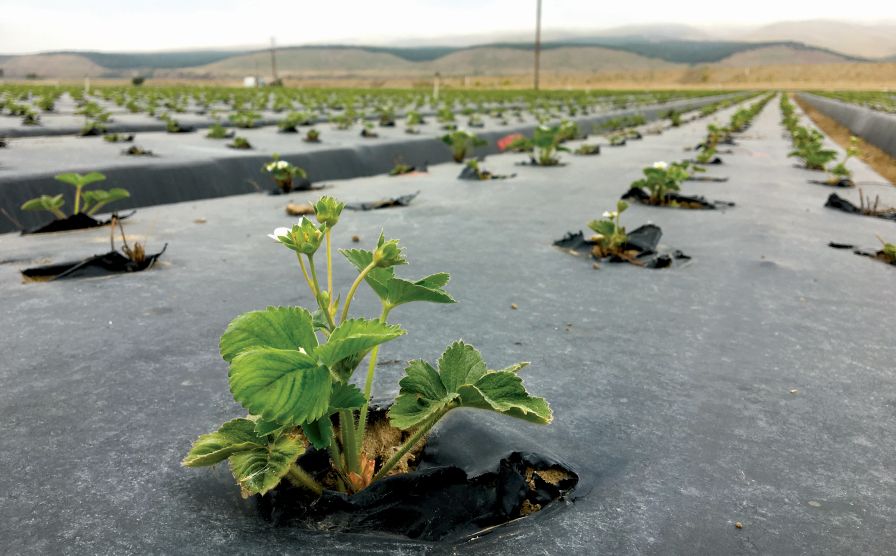Tips to Control Rodents in Drip-Irrigated Strawberries

With a proactive approach and a few key strategies, strawberry growers can ensure rodents don’t wreak havoc on their crop and drip irrigation system. (Photo: Danilu Ramirez)
Rodents are a major concern for all strawberry growers, including those with drip irrigation systems.
Pests like pocket gophers, moles, squirrels, and voles, when not properly managed, eat the plants and fruit, causing crop damage and yield loss. In addition to damaging the crop, some rodents attack drip tape. It’s expensive and time-consuming to replace, giving growers who employ a drip irrigation strategy even more incentive to ward off rodents.
The good news is, it doesn’t take highly innovative practices or a cutting-edge approach to control rodents in strawberry fields. In fact, most growers can be successful with heightened awareness and by implementing a few best practices. While strawberry growers do have the added consideration of food safety regulations to account for, there are still several steps they can take to control rodents, and prevent costly damages and yield loss.
Because there isn’t one, “magic” solution for controlling rodents, strawberry growers can build a good, integrated defense with these 10 tips.
Early Identification
The first line of defense in the war on rodents begins in the early stages of the growing season.
1. Prior to planting, growers often fumigate fields to prevent disease. This practice can also help eliminate moles that feed on earthworms in the soil. Because of food safety regulations that go hand-in-hand with strawberry production, all growers need to check with their local agricultural commissioner for registered fumigants that are approved to use.
2. Voles are drawn to areas around a strawberry field, too – particularly, overgrown fields and ditches, so it’s advised to eliminate excess weeds, ground cover, and growth.
3. Organic fields tend to have more rodent activity, as soils have not been conventionally fumigated and fields are often surrounded by high vegetation areas. Rodents tend to damage drip tape as they search for water sources. If this happens, consider replacing 5 5-millimeterape with a stronger tape that has a thickness of 12 millimeters or more.

Organic strawberry fields tend to
have more rodent activity compared to conventional fields. (Photo: Danilu Ramirez)
Control While You Grow
The bulk of rodent management activities take place throughout the growing season, on an ongoing basis.
4. Be on the lookout for mounds, particularly, fan-shaped, and mole hills, as they’re the first sign a pocket gopher or mole has made its home.
5. Upon identifying mounds and hills, set traps on both tunnel entrances.
6. Growers can also destroy mole hills by stomping them, but should take note if they’re rebuilt within a couple days. If so, the moles are active and more attention should be paid to the area.
7. Squirrels tend to be a bigger problem in the summer, when their spring food supplies are starting to run out. Because they tend to stay near perimeter fences, it’s recommended to run PVC pipe along a fence, and put bait inside the pipe.
Timing and Timelines
Paying attention to seasonal factors and keeping track of efforts are the final keys to a quality rodent management plan.
8. To best monitor and address issues now and in the future, keep detailed records of where and when damage occurs.
9. It’s also advisable to track the number of pests destroyed in given time periods, as the spikes will help to show when more attention is required.
10. In warm areas where growers farm winter-planted berries, the spring and summer seasons are both crucial times to take action and closely track efforts. Growers who plan in the summer, are proactive early in the fall season, and remain vigilant all the way through to the end of harvest, will attain the best results.
Not Good Luck, Good Planning
One final piece of advice isn’t necessarily part of an ongoing program but is highly recommended — don’t be afraid to ask for help. Seek out the advice of fellow strawberry growers who operate drip systems, as well as rodent management experts and local Extension agents.
With proper planning and ongoing best management practices, rodent threats can be minimized in strawberry fields with drip irrigation systems, allowing growers to enjoy the benefits of reduced water use and greater yields, leading to better water and resource use efficiency (WUE and RUE).










